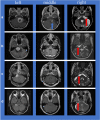Surgical management of primary and secondary pilocytic astrocytoma of the cerebellopontine angle (in adults and children) and review of the literature
- PMID: 32297071
- PMCID: PMC8035087
- DOI: 10.1007/s10143-020-01293-4
Surgical management of primary and secondary pilocytic astrocytoma of the cerebellopontine angle (in adults and children) and review of the literature
Abstract
Glial tumors in the cerebellopontine angle (CPA) are uncommon and comprise less than 1% of CPA tumors. We present four cases of pilocytic astrocytoma of the CPA (PA-CPA) that were treated in our department. Patients who received surgical treatment for PA-CPA from January 2004 to December 2019 were identified by a computer search of their files from the Department of Neurosurgery, Tübingen. Patients were evaluated for initial symptoms, pre- and postoperative facial nerve function and cochlear function, complications, and recurrence rate by reviewing surgical reports, patient documents, neuroradiological data, and follow-up data. We identified four patients with PA-CPA out of about 1500 CPA lesions (~ 0.2%), which were surgically treated in our department in the last 16 years. Of the four patients, three were male, and one was a female patient. Two were adults, and two were children (mean age 35 years). A gross total resection was achieved in three cases, and a subtotal resection was attained in one case. Two patients experienced a moderate facial palsy immediately after surgery (House-Brackmann grade III). In all cases, the facial function was intact or good (House-Brackmann grades I-II) at the long-term follow-up (mean follow-up 4.5 years). No mortality occurred during follow-up. Three of the patients had no recurrence at the latest follow-up (mean latest follow-up 4.5 years), while one patient had a slight recurrence. PA-CPA can be safely removed, and most complications immediately after surgery resolve in the long-term follow-up.
Keywords: Brainstem; CPA; Cerebellopontine angle; Facial nerve; Glioma; Pilocytic astrocytoma.
Conflict of interest statement
The authors declare that they have no conflicts of interest.
Figures


References
Publication types
MeSH terms
LinkOut - more resources
Full Text Sources
Medical

